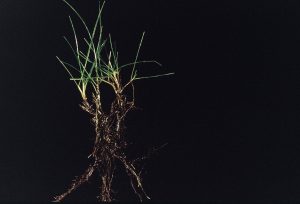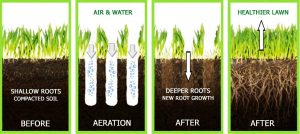The importance of air gaps within your soil
Our lawns get a lot of foot traffic. We are out there barbecuing, kicking a ball around, playing with the dog or pegging out the laundry. Over time this foot traffic can compact the soil beneath your lawn, gradually reducing the air gaps which are essential to life. Less air means fewer insects that break down dead plant material. It also means less microbial activity and this is a major issue. These beneficial microbes create a relationship with the plant roots, they make important nutrients available to the plant and they produce growth hormones and help protect the plant from pests, parasites and diseases. Fewer microbes means that the balance of nature is being upset – don’t upset Mother Nature!
Feeling gassy
Air gaps within the soil are also essential for the health of the plant. Without air your grass would die. Plants don’t just breathe through their leaves, for roots to be healthy they too must breathe. Roots take in oxygen through tiny hairs within the gaps in the soil, they use this oxygen and then expel carbon dioxide. If the plant roots have limited access to air gaps within the soil then this gaseous exchange is compromised and the plant will be weakened, making it less vigorous and more susceptible to attack from pests and disease.

Roots are your lawn’s access to nutrition
Loosen up man
So, you may we wonder what we can do to help nature along and create a healthier environment for all this subterranean activity. The answer is aeration. What’s aeration I hear you ask. Let me explain; aeration is the mechanical introduction of air spaces within your lawn soil to provide the essential balance needed to support soil life and healthy roots.
In its most simple form, you could do this with a garden fork. Stamp the fork into the ground, rock it back and forth, remove and repeat – over the whole lawn area. Trust me, this is really hard work and there are better ways to work up a sweat. Lawn care professionals use a petrol-powered machine specifically designed for the task. It’s still hard work but its far more effective than a garden fork. The aerator is fitted with a metal tine that is driven deep into the ground to create a hole. If a hollow tine is used it pulls out a small plug of soil which is deposited on the surface of the lawn and soon breaks down. The surrounding soil now has the space to ‘relax’ into the hole, creating cracks and gaps within the soil and more air spaces essential to life.
These newly created holes also allow dead plant matter into the soil where it can decompose and be broken down by insects and beneficial microbes, therefore creating a healthier soil environment.
Root pruning
The sharp edge of a hollow tine cuts into the soil and also cuts through the roots of the grass plants. When these roots re-grow they do so in a more fibrous way and this gives them a greater surface area. More roots mean more access to food, water and air – the essentials for a healthy plant. Aeration is by far the most beneficial mechanical process for any lawn and should ideally happen at least once a year.

Lawn aeration aids root development
Drainage issues
Finally, compaction issues are often responsible for water-logging. When the air gaps become filled with water instead of air they prevent the roots from accessing the essential air needed for life. The lack of air in the soil also impacts the life of beneficial bacteria and promotes the life of damaging bacteria which reproduce in anaerobic environments, This virtual ‘soil death’ will result in actual grass plant death. Regular aeration relieves compaction which can reduce waterlogging.

 Established 2016
Established 2016



